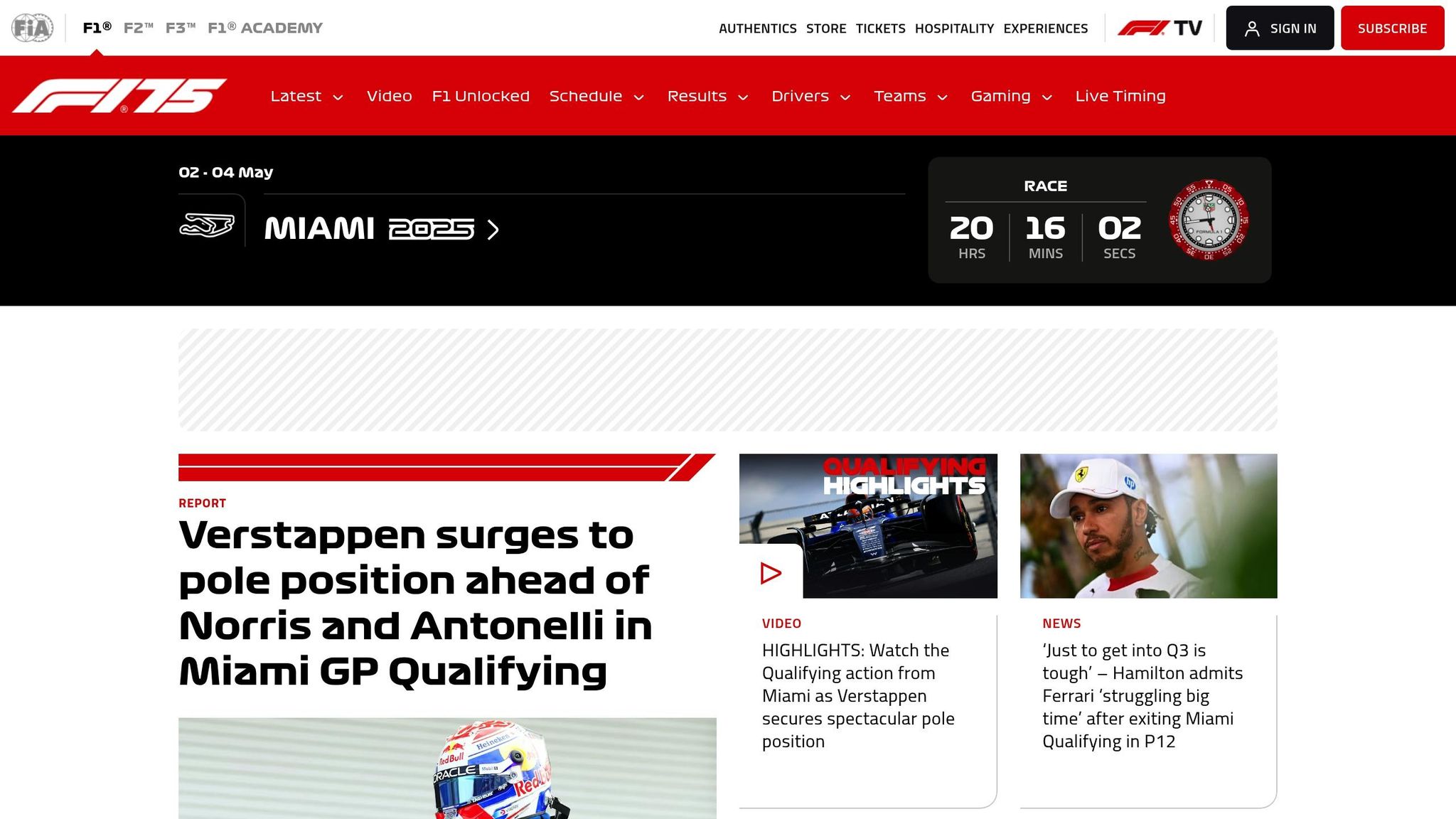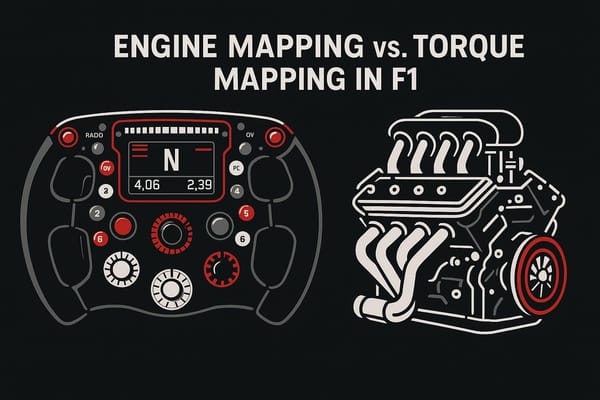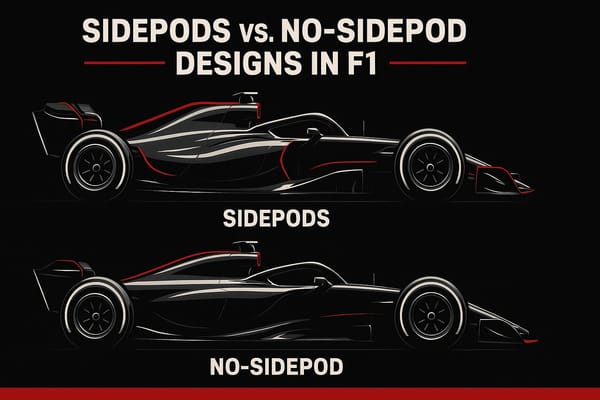How F1 Cars Manage Fuel During Races
Explore how F1 cars balance speed and fuel efficiency through advanced technology, real-time monitoring, and driver techniques.

Fuel management in Formula 1 is a game of precision. Teams must balance speed, fuel efficiency, and strict regulations to stay competitive. Here’s what you need to know:
- Fuel Limits: Cars can carry a maximum of 110 kg of fuel per race, with a fuel flow cap of 100 kg/h above 3,000 rpm.
- Hybrid Systems: Energy recovery systems (ERS) like KERS and MGU-H help reduce fuel use by capturing energy from braking and exhaust heat.
- Real-Time Monitoring: Teams track metrics like fuel flow and energy recovery rates to adjust strategies during the race.
- Driver Techniques: Methods like "lift and coast" and precise throttle control help drivers save fuel without losing performance.
F1’s fuel strategies are shaped by cutting-edge technology, driver skill, and the sport’s push toward sustainable racing. Want to know how they achieve this balance? Let’s dive in.
Formula 1 Fuel Explained

Fuel Efficiency Technology
Modern F1 cars are equipped with advanced combustion engines and energy recovery systems, designed to improve both performance and fuel efficiency. Here's a closer look at the key technologies driving these advancements.
Hybrid Power Systems
F1 cars rely on hybrid power units that combine traditional combustion engines with two energy recovery systems: KERS (Kinetic Energy Recovery System) and MGU-H (Motor Generator Unit - Heat). These systems work together to cut fuel usage by capturing and reusing energy:
- KERS (or MGU-K): Captures energy from braking, storing up to 2 MJ per lap and deploying up to 4 MJ when needed.
- MGU-H: Recovers heat energy from exhaust gases, operating within strict regulations to maximize efficiency.
This combination ensures that energy is not wasted, but instead converted into additional power when required.
Fuel Data Tracking
Real-time telemetry plays a crucial role in managing fuel efficiency during races. Teams monitor several key metrics to fine-tune strategies on the go:
| Data Point | Purpose | Strategic Impact |
|---|---|---|
| Instant Fuel Flow | Tracks consumption rates | Helps teams adjust driving strategies |
| Energy Recovery Rates | Assesses ERS performance | Balances energy use with fuel conservation |
This data allows teams to strike the perfect balance between speed and efficiency, ensuring optimal performance throughout the race.
Race Fuel Planning
In Formula 1, teams carefully calculate fuel loads to balance performance and efficiency while staying within strict regulations. Using a mix of historical data, practice session metrics, and track conditions, they determine exactly how much fuel is needed for optimal performance. These strategies are vital for both pre-race setups and in-race decisions.
Starting Fuel Calculations
Before the race, teams run simulations to account for factors like circuit layout, weather, and expected race pace. This helps them optimize the starting fuel load - enough for competitive speed without adding unnecessary weight that could slow the car down.
Mid-Race Fuel Adjustments
During the race, teams monitor real-time factors like weather changes, safety car periods, and shifting race dynamics. This allows them to tweak fuel usage on the fly - saving fuel when conditions allow while ensuring there’s enough for a strong finish.
Balancing Speed and Fuel Economy
One of the toughest challenges is deciding when to prioritize speed over fuel conservation. Teams must weigh the risks and rewards of aggressive driving, which burns more fuel, against the need to save enough for the final laps. Striking this balance is key to achieving a competitive result.
Driver Fuel-Saving Methods
While advanced car systems play their part, drivers have a major influence on fuel efficiency. In Formula 1, racers use specific techniques to manage fuel effectively, even under the intense demands of competition.
Lift and Coast: How It Works
The "lift and coast" technique is a key fuel-saving method in F1. Drivers ease off the throttle earlier than usual before corners, letting the car coast briefly while maintaining momentum. This tactic is especially useful on tracks with long straights followed by heavy braking zones, like Monza or Spa-Francorchamps.
Here’s how drivers make the most of it:
- They release the throttle at just the right moment to minimize speed loss.
- Energy recovery systems kick in during braking, capturing extra power.
By combining coasting with energy recovery, this method helps conserve fuel without sacrificing too much performance.
Mastering Throttle and Brake Control
Controlling the throttle and brakes is essential for fuel efficiency in today’s F1 cars. Drivers must find the right balance between applying power and recovering energy. Smooth, precise pedal inputs ensure the hybrid systems recover as much energy as possible, reducing fuel consumption. This level of control not only saves fuel but also highlights the skill that sets top drivers apart.
Driving Styles and Fuel Efficiency
A driver’s approach on the track can significantly influence fuel use. Some naturally drive in a way that conserves fuel, while others adjust their techniques to hit specific fuel targets. Smooth steering and pedal inputs tend to result in better fuel economy compared to aggressive driving.
Fuel-efficient racing also depends on entering corners at the right speed and choosing strategic racing lines. Teams analyze telemetry data to refine their drivers’ techniques, ensuring they remain competitive while managing fuel effectively.
Fuel Strategy Results
F1 cars operate under strict fuel regulations, starting each race with about 110 kg of fuel and adhering to a maximum fuel flow rate of 100 kg/h above 3,000 rpm. These rules play a critical role in shaping race strategies, including fuel management and pit stop planning.
Key Fuel Strategy Moments
Fuel strategies, combined with earlier planning and driver tactics, directly shape race dynamics. The introduction of hybrid power units has added a layer of complexity, as teams must carefully balance traditional fuel use with energy recovery systems. This balance affects performance at different race stages:
| Race Phase | Fuel Strategy Focus | Impact on Performance |
|---|---|---|
| Opening Laps | Aggressive fuel use for position gains | Higher consumption but better track position |
| Mid-Race | Balanced approach with fuel saving | Maintains pace while conserving fuel reserves |
| Final Laps | Strategic fuel deployment | Maximizes performance with remaining fuel |
Fuel and Pit Stop Planning
Pit stop strategies are closely tied to fuel consumption and tire changes, with adjustments based on factors like track layout, weather, tire wear, and race pace. Teams continuously tweak their plans by considering:
- Track Layout: Each circuit demands a different fuel strategy.
- Weather Conditions: Factors like temperature and humidity influence fuel efficiency.
- Tire Degradation: Fuel usage must align with tire wear rates.
- Race Pace: Real-time performance data shapes fuel targets during the race.
Advances in Fuel Technology
As F1 pushes toward more sustainable racing, advancements in fuel technology remain a priority. While hybrid systems have already transformed fuel management, future innovations may include improved energy recovery systems and optimized fuel formulations. These developments aim to ensure every ounce of fuel contributes to peak performance, aligning with broader trends in automotive technology.
Conclusion
F1 fuel management is a delicate balance between performance and regulation. The introduction of hybrid power systems has reshaped fuel strategies, aligning with F1's move toward greener racing while keeping the competition fierce.
This system hinges on three key factors: advanced monitoring technology, strategic race planning, and skilled driver execution. Together, these elements ensure fuel is used efficiently without sacrificing speed or performance.
Looking ahead, F1 is working on developing more efficient fuel technologies as part of its commitment to environmentally conscious racing. Achieving effective fuel management requires seamless collaboration between engineers, strategists, and drivers, showcasing how modern F1 teams push performance limits within strict rules.
The progression of fuel efficiency in the sport highlights F1's role as a leader in motorsport innovation, advancing technology while addressing environmental goals. This approach blends advanced tools with smart strategies to deliver peak race performance.
FAQs
How do F1 teams determine the right amount of fuel for a race?
Formula 1 teams carefully calculate the optimal fuel load before each race to balance performance and efficiency. They consider factors like the track layout, expected weather conditions, and tire strategy. Tracks with long straights or high-speed sections typically require more fuel, while slower circuits may allow for lighter fuel loads.
Teams also analyze data from practice sessions and simulations to estimate fuel consumption per lap and account for variables like safety car periods or changes in race pace. The goal is to carry just enough fuel to complete the race without adding unnecessary weight, ensuring maximum performance while avoiding running out of fuel before the finish line.
How do energy recovery systems like KERS and MGU-H help F1 cars save fuel during races?
Energy recovery systems such as KERS (Kinetic Energy Recovery System) and MGU-H (Motor Generator Unit - Heat) play a crucial role in improving fuel efficiency in Formula One. These systems capture and reuse energy that would otherwise be wasted during a race.
KERS stores kinetic energy generated during braking and converts it into electrical energy, which can be deployed to boost the car's performance without consuming additional fuel. Similarly, the MGU-H recovers heat energy from the turbocharger and converts it into electricity, which can either be used immediately or stored for later use. By supplementing the car's power output with these recovered energies, F1 teams reduce the reliance on fuel, allowing for better efficiency without compromising speed or performance.
How do F1 drivers maintain speed while using fuel-saving techniques like 'lift and coast' during a race?
F1 drivers use a technique called lift and coast to save fuel without sacrificing too much performance. This involves lifting off the throttle earlier before braking into a corner, allowing the car to decelerate naturally and reducing fuel consumption. By carefully timing this, drivers can maintain competitive lap times while conserving fuel for critical moments in the race.
Teams monitor real-time data to help drivers strike the perfect balance between speed and efficiency. Factors like track layout, tire wear, and race strategy all influence when and how often these techniques are used, ensuring drivers stay competitive while managing fuel effectively.




